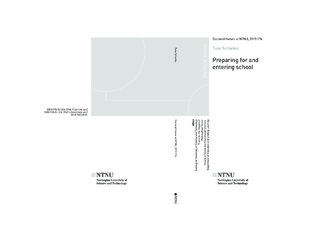| dc.contributor.advisor | Aarsand, Pål | |
| dc.contributor.advisor | Hammerstad, Gøril Thomassen | |
| dc.contributor.author | Schanke, Tuva | |
| dc.date.accessioned | 2019-10-01T13:34:18Z | |
| dc.date.available | 2019-10-01T13:34:18Z | |
| dc.date.issued | 2019 | |
| dc.identifier.isbn | 978-82-326-3949-6 | |
| dc.identifier.issn | 1503-8181 | |
| dc.identifier.uri | http://hdl.handle.net/11250/2619671 | |
| dc.description.abstract | Sammendrag
Denne studien omhandlet barns deltakelse i skoleforberedende aktiviteter (SFA) i barnehage og utvalgte aktiviteter i første trinn. Det sentrale var å utforske interaksjoner mellom barna (5-6-åringer) og mellom barna og de voksne, samt å undersøke organiseringen av aktiviteter før og etter skoleovergangen. Tre forskningsspørsmål ble besvart.
Hvordan deltar barn i SFA? SFA fant sted hver uke og omfattet kortere og lengre turer, prosjekter og aktiviteter med fokus på bokstaver, tall og tegning. I alle slike aktiviteter deltok barna i et fellesskap, der inkludering og samhold var sentrale verdier. Barna var aktive og samarbeidet om å gjennomføre ulike aktiviteter, og de brukte verbale, kroppslige og materielle ressurser for å dele kunnskap og støtte hverandre. Barna ledet også aktiviteter selv, og de endret på vokseninitierte aktiviteter slik at de ble mer interessante.
Hvordan deltar barn i helgruppe i første trinn? I skolen ble barna organisert annerledes enn i barnehagen; individuelt, parvis og smågrupper. Lyttekroken var en daglig helgruppeaktivitet hvor barna satt i en hestesko vendt mot læreren og tavla. Læreren ledet lyttekroken og stilte ofte «fasitspørsmål» og fordelte ordet. Tross at mange regler regulerte barnas atferd (sitte stille, rekke opp hånda), avdekket studien at barna utfordret reglene for å kunne ta mer del i aktivitetene (hviske beskjeder, repetere ord, argumentere for hverandre).
Hvordan forholder barns deltakelse i SFA seg til aktiviteter i første trinn? SFA var gruppeaktiviteter der barna ofte bestemte innholdet og gjennomføringen, og der mange barn deltok på ulike måter på samme tid. Skoleaktiviteter var ofte voksenstyrte, med få deltakerposisjoner, og barna valgte sjelden innholdet. Selv om det var en annen organisering og andre regler i første trinn enn i SFA, så fortsatte barna å samarbeide og bruke hverandre som ressurser i å finne svar og skape mer aktiv deltakelse.
Studiens teoretiske og metodologiske innramming var inspirert av etnometodologi, konversasjonsanalyse og barndomsstudier. De empiriske data besto av 130 timer film og 60 sider feltnotater innhentet ved to barnehager og to skoler fra november 2013 til november 2014. Studien fulgte 24 barn i barnehage og 45 barn i skolen. Avhandlingen omfattet en kappe og tre artikler/dybdestudier av bokstavaktiviteter, tallaktiviteter og lyttekrok. | nb_NO |
| dc.description.abstract | Summary
This thesis was about children's participation in school preparation activities (SPAs) in kindergarten and selected activities after the entry to school. The study explored children's (5-6-year-olds) manners of interacting with other children and with adults in the activities, and it also examined the organization of activities. Three research questions were discussed:
How do children participate in SPAs in kindergarten? SPAs were done on a weekly basis, and it included trips, projects, and activities focused on letters, numbers and drawing. All types of SPAs were carried out with the whole group of children, and values like inclusion and unity were important. The children cooperated to accomplish activities, and they used talk, embodied actions and material resources to share knowledge and support each other.
How do children participate in whole-group activities in first grade? Activities were organized different in school than kindergarten; individually, pairs, and small groups. The ‘listening corner’ was a common whole-group activity where children sat in a semi-circle facing the teacher and the blackboard. The teacher led the activity and asked known information questions. Many rules regulated the conduct of the children (sit still, raise hands), but the children challenged these rules to take more active part (whispered messages, recycled, made arguments).
How does children's participation in SPAs relate to activities in the first grade? The children often decided about SPAs and were offered various participatory positions. First-grade activities were adult-led, with few participatory positions and less choice of content. Despite the different organization and rules in first-grade, the children continued to cooperate, and they used each other as resources to create more active modes of participation.
Ethnomethodology, conversation analysis and childhood studies inspired the theoretical and methodological approach. The data included 130 hours of video and 60 pages with fieldnotes. They were from a fieldwork in two kindergartens and two schools from November 2013 to November 2014. 24 children were video-recorded in kindergarten and 45 children were video-recorded in first grade. The thesis included an extended abstract and three articles with fine-grained analyses of a letter activity, a number activity and listening corners. | nb_NO |
| dc.language.iso | eng | nb_NO |
| dc.publisher | NTNU | nb_NO |
| dc.relation.ispartofseries | Doctoral theses at NTNU;2019:176 | |
| dc.relation.haspart | Paper 1:
Schanke, Tuva.
Children’s participation in a school-preparation letter activity. Childhood 2018 ;Volum 26.(1) s. 113-131
https://doi.org/10.1177/0907568218810092 | |
| dc.relation.haspart | Paper 2:
Schanke, Tuva
Doing numbers in preschool: Children’s
cooperation in a number activity.
The final published version is available in Research on Children and Social Interaction, 4(2), 267–291. https://doi.org/10.1558/rcsi.12408 | |
| dc.relation.haspart | Paper 3:
Schanke, T.
Children’s participation in first grade: Mastering,
challenging and breaking rules in listening corners. | |
| dc.title | Preparing for and entering school | nb_NO |
| dc.type | Doctoral thesis | nb_NO |
| dc.subject.nsi | VDP::Social science: 200::Education: 280 | |
